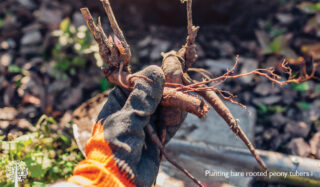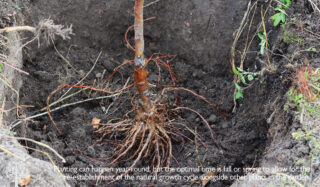A few years ago, my local garden center started selling bare-root plants. The assortment went above and beyond the typical dahlia tuber or lily bulb and included shrubs, trees, and a variety of perennials. What was this madness? I did a little digging and learned that bare root planting is easy and is becoming increasingly popular among anyone with an itch to garden on a budget.
What Are They?
Bare root plants are dormant perennials, shrubs, or trees grown in nurseries, dug up during their dormant period, and roots washed of soil.
They are packaged and kept dormant in cool warehouses until they are ready to be shipped to the customer via mail order or to the garden center, where they are sold directly.
They are often deciduous plants with stalks trimmed just above the root line. Berry bushes, fruit trees, and a wide range of perennials, including lilacs, camellia bushes, clematis, and, of course, roses of all varieties, from floribunda to climbing, can all be planted from bare roots. It’s a super affordable way to start a permaculture-style mini-food forest on the cheap!

Reduced Carbon Footprint
Because bare root plants are not packed in soil hyper-stimulated with fertilizer to enhance growth, their carbon footprint is less than regularly purchased container plants.
Each root can be packed tightly with others, reducing the area and cost needed to ship; transporting one box of roots takes less energy than ten containers of fully-grown plants.
As a bonus, bare root plants are often 30-50% less expensive than others in pots because those additional shipping and material costs aren’t passed on to the consumer.
Growing Advantages
According to Cornell University, a bare-root tree contains 200% more roots than the same tree sold in a container. Impressive!
Bare-root plants frequently establish more quickly than container plants because roots aren’t transitioning from container earth to local soil. This can lead to better survival rates and a healthier plant with more vigorous growth.

Wake Up!
Once you get your bare root plant – the next step is to wake it up from its dormant state.
The roots are bound together and encased in sawdust, peat, or coir to prevent moisture accumulation. The first step is to untie the roots, shake off the packaging, and soak them in cool water for a few hours.
This process re-initializes the stagnant sugars in the root and starts the growth cycle. If it is impossible to plant immediately, keep the plant cool but not frozen so dormancy is maintained.
Planting
Planting can happen year-round, but the optimal time is fall or spring to allow for the re-establishment of the natural growth cycle alongside other plants in the garden.
Sprinkling mycorrhizal fungi around the root at the time of planting will help increase nutrient and water uptake from the soil.
Once planted, feeder roots will start to spread. It may take a few weeks to see any signs of life, so don’t panic! Be sure to keep the soil watered if it feels dry. Eventually, new shoots will appear, indicating that the root has broken dormancy and is growing.
And that’s it. Bare root planting may sound a little off-putting, but the results are often a healthier plant at a lower cost. So what do you have to lose?